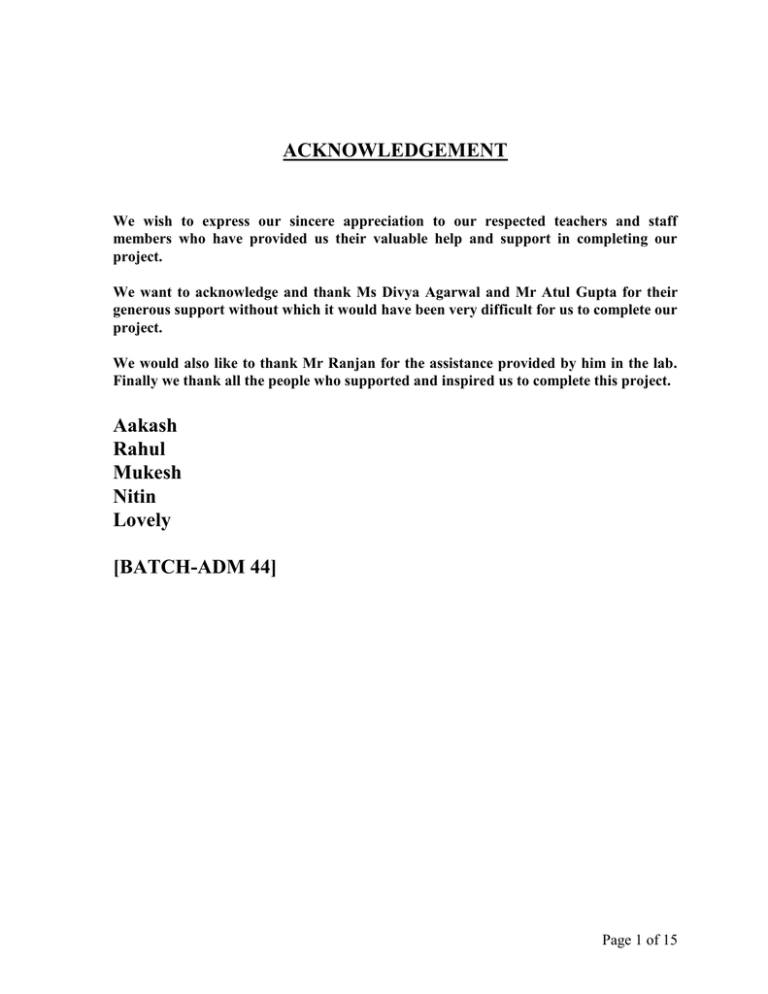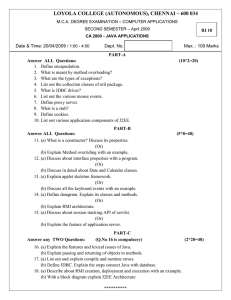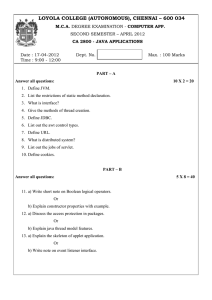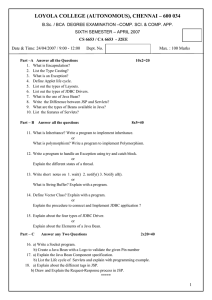ACKNOWLEDGEMENT
advertisement

ACKNOWLEDGEMENT We wish to express our sincere appreciation to our respected teachers and staff members who have provided us their valuable help and support in completing our project. We want to acknowledge and thank Ms Divya Agarwal and Mr Atul Gupta for their generous support without which it would have been very difficult for us to complete our project. We would also like to thank Mr Ranjan for the assistance provided by him in the lab. Finally we thank all the people who supported and inspired us to complete this project. Aakash Rahul Mukesh Nitin Lovely [BATCH-ADM 44] Page 1 of 15 INDEX Content Page 1.Shopping on net 2.Client Server Architecture 3 3 2.1 Two tier architecture 2.2 Three tier architecture 3.Servlets-Preface 4 3.1 Java Servlets 3.2 Support for Servlets 3.3 Advantages of Servlets 3.4 Servlet Structure 3.5 GET and POST 3.6 Servlet Lifecycle 3.7 Session Tracking 4.HTTP 10 4.1 HTTP Basics 5. JDBC(Java Database Connectivity) 11 5.1 JDBC Basics 5.2 Getting a Connection 5.3 Executing SQL Queries 6. JavaScript 7. HTML 8. Java API 9. References 13 14 14 15 Page 2 of 15 1. Shopping On Net Shopping online has its perks - you can buy what you like, no matter what it is. While some people love shopping at their local store, for others it's little more than a race between trollies and ending up in the longest queue, despite thoroughly analysing the situation. Now any supermarket worth its ginger nuts is going to provide some form of web shopping so it's worth checking out especially if you're ill or just too busy in your advanced 21st century lifestyle to fit in these oh-so-tiresome chores. For those who love shopping, find in a minority. Once a popular hobby, it is now regarded as a chore to be avoided at all costs by a large proportion of the population. Shopping online helps customer to save time and find variety of product in shortest duration 2. Client Server architecture The client/server architecture is a versatile, message based and modular infrastructure that is intended to improve compared to centralized, mainframe, timesharing computing. The term client/server was first used in the 1980s in reference to personal computers on a network. The actual client/server model started gaining acceptance in the late 1980s. A client is defined as a requester of services and a server is defined as a provider of services. A single machine can be both a client and a server. This architecture emerged due to the limitations of file sharing architecture. This approach introduced a database server to replace the file server. Using a relational database management system, user queries could be answered directly. This reduced network traffic by providing query response rather than total file transfer. It improves multi-user updating through GUI front end to shared database. In client-server architectures, standard query language (SQL) statements are typically used to communicate between the client and server. 2.1. Two-Tier Architecture In two-tier client-server systems, the application logic is either buried inside the user interface or on the client within the database on the server. For example file servers & database servers with stored procedures. Page 3 of 15 2.2. Three-Tier Architecture In three-tier client-server systems, the application logic or process lives in middle tier, i.e., it is separated from the database & the user interface. In this case, processes can be managed and deployed separately from the GUI and the database, for example the web and distributed objects. 3. Servlets-Preface Java servlets are a key component of server side Java development. A servlet is a small pluggable extension to a server that enhances the server’s functionality. Servlets allow developers to extend and customize any Java enabled server-a web server mail server or an application server with a great degree of portability, flexibility and ease. 3.1. Java Servlets: A Servlet is a generic server extension ---a Java class that can be loaded dynamically to expand the functionality of a server. A servlet runs inside a Java Virtual Machine (JVM) on the server, so it is safe and portable. Servlets operate solely within the domain of the server: unlike applets, they do not require support for Java in the web browser. All of the major web servers support servlets, but Java servlets offer the best possible platform for application development. Most servlet developers design and deploy servlets for use with HTTP servers. 3.2. Support for servlets: Servlets are supported on all platforms that support Java, and Servlets work with all the major web servers. The javax.servlet and javax.servlet.http packages constitute a set of classes that provide basic servlet support.Version2.0 of these classes comes bundled with the Java Servlet Development Kit (JSDK) for use with the Java Development Kit version1.1 and above. 3.3. Advantages of a Servlet: Page 4 of 15 Servlets have several substantial advantages over contemporary technologies. These are: 1. Capable of running in process; 2. Compiled; 3. Crash resistant; 4. Cross platform; 5. Cross server; 6. Durability and Efficiency; 7. Dynamically loaded across the network; 8. Extensibility and Flexibility; 9. Protocol independent; 10. Secure and Portable; Servlets are tightly integrated with the server. Servlet can use the server to translate file paths, perform logging, check authorization, perform MIME type mapping, and, in some cases, even add users to the server’s user database. 3.4. Servlet Structure: Practically all servlets that perform some useful function have two things in common. First, they all extend one of the two servlet classes--GenericServlet or HttpServlet. Extending these classes provides a framework for creating servlet as well as default functionality. The method that is automatically called by the server in response to a client request is called service ( ). A generic servlet should override its service ( ) method to handle requests as appropriate for the servlet. The service ( ) method accepts two parameters: a request object and a response object. In contrast, an HTTP servlet usually does not override the service ( ) method.Instead, it overrides doGET ( ) to handle GET requests and doPOST ( ) to handle POST requests. An HTTP servlet can override either or both of these methods, depending on the type of requests it need to handle. The service ( ) method of HTTP Servlet handles Page 5 of 15 the setup and dispatching to all the doxxx ( ) methods, which is why it usually not be overridden. 3.5. GET and POST: The GET method is designed for getting information(a document, a chart, or the results from a database query),while the POST method is designed for posting information(a credit card number, some new chart data, or information that is to be stored in a database). In addition to classes and methods, there are two important methods that are implemented by most servlets---init ( ) and destroy ( ). The init ( ) method is called a single time when the servlet is first loaded. It is similar to a class constructor in that it provides a method wherein initialization code is guaranteed to be run. The destroy ( ) method is executed when the servlet is unloaded. It is used to free any resources held by the servlet. 3.6. Servlet Lifecycle: The process by which a server invokes a servlet can be broken down into nine steps. The steps are:1. The server loads the servlet when it is first requested by a client or, if configured to do so, at server start up. 2. The server creates one or more instances of the servlet class. Depending on the implementation, the server may create a single instance that services all requests through multiple threads or create a pool of instances from which one is chosen to service each new request. 3. The server constructs a ServletConfig object that provides initialization information to the servlets. 4. The server calls the servlet’s init ( ) method, passing the object constructed in step 3 as a parameter. The init ( ) method is guaranteed to finish execution prior to the servlet processing the first request. 5. The server constructs a ServletRequest or httpServletRequest object from the data included in the client’s request. It also constructs a ServletResponse or httpServletResponse object that provides methods for customizing the server’s response. Page 6 of 15 6. The servlet calls the servlet’s service ( ) method (or, other more specific method like doGet ( ) or doPost ( ) for HTTP servlets), passing the objects constructed in step 5 as parameters. 7. The service ( ) method processes the client request by evaluating the ServletRequest or HttpServletRequest object and responds using the ServletResponse or HttpServletResponse object. 8. If the server receives another request for this servlet, the process begins again at step 5. 9. When instructed to upload the servlet, perhaps by the server administrator or programmatically by the servlet itself, the server calls the servlet’s destroy ( ) method. The servlet is then eligible for garbage collection. Page 7 of 15 Server loads the servlet Server creates one or more instances Of the servlet class Server calls the init ( ) method for Each servlet instance Servlet request is received Server selects servlet instance and Calls its service ( ) method Servlet’s service ( ) method processes The request and returns output to Client Servlet waits until next request is Received or it is unloaded by server Server unloads the servlet after Calling its Destroy ( ) method. Page 8 of 15 3.7. Session Tracking HTTP is stateless Protocal, which means that each request is independent of the previous one. However, in some applications, it is necessary to save state information so that information can be collected from several interactions between a browser and a server. Sessions provide such a mechanism. Session tracking is a mechanism for building a sophisticated state-aware model on top of the web's stateless protocol. With session tracking, the server maintains session state through the use of cookies or URL rewriting. The server creates new sessions, invalidates old sessions, and maintains policies of session persistence. A session can be created via the getSession ( ) method of HttpServletRequest. AnHttpSession object is returned. This hobject can store a set of bindings that associate names with objects. The putValue ( ), getValueNames ( ), and removeValue ( ) methods of HttpSession manage these bindings. It is important to note that session state is shared among all the servlets that are associated with a particular client. 3.7.1. Introduction to Session Tracking Session tracking is a flexible, lightweight mechanism that enables stateful programming on the web. Its general implementation serves as a basis for more sophisticated state models, such as persistent user profiles or multi-user sessions. A session is a series of requests from the same user that occur during a time period. This transaction model for sessions has many benefits over the single-hit model. It can maintain state and user identity across multiple page requests. It can also construct a complex overview of user behavior that goes beyond reporting of user hits. 3.7.2. Server-Side Session Objects and Users Session tracking gives servlets and other server-side applications the ability to keep state information about a user as the user moves through the site. Server-side applications can use this facility to create more stateful user experiences and to track who's doing what on the site. The Java Web Server maintains user state by creating a Session object for each user on the site. These Session objects are stored and maintained on the server. When a user first makes a request to a site, the user is assigned a new Session object and a unique session ID. The session ID matches the user with the Session object in subsequent requests. The Session object is then passed as part of the request to the servlets that handle the request. Servlets can add information to Session objects or read information from them. Page 9 of 15 3.7.3. Session Endurance After the user has been idle for more than a certain period of time (30 minutes by default), the user's session becomes invalid, and the corresponding Session object is destroyed. A session is a set of requests originating from the same browser, going to the same server, bounded by a period of time. Loosely speaking, a session corresponds to a single sitting of a single anonymous user (anonymous because no explicit login or authentication is required to participate in session tracking). 3.7.4. URL rewriting Boolean value indicating whether Java Web Server uses rewritten URLs as a vehicle to carry the session ID If true, then session IDs arriving in the URL are recognized, and the Java Web Server rewrites URLs if necessary to send the session ID.Default value of rewriting is false. 4. HTTP(Hyper Text Transfer Protocol): The HTTP is a stateless, TCP/IP based protocol used for communicating on the World Wide Web. HTTP defines the precise manner in which Web clients communicate with Web Browsers.HTTP/1.0 is the most common version in use today. 4.1. HTTP Basics: The HTTP protocol follows a very simple request/response paradigm. In short, a conversation between a Web browser and Web server goes something like this: The client opens a connection to the server, the client makes a request to the server, the server responds to the request, and the connection is closed. *HTTP is a connectionless protocol: The difference between a connectionless and a connection-oriented protocol is in the way they handle connections. Using a connectionless protocol, the client opens a connection with a server, sends a request, receives a response, and closes the connection. Each request requires its own connection. With a connection-oriented protocol, the client connects to the server, sends a request, receives a response, and then holds the connection open in order to service future request. Page 10 of 15 *HTTP is a stateless protocol: A protocol is said to be stateless if it has no memory of prior connections and cannot distinguish one client’s request from that of another. In contrast, FTP is a stateful protocol, because the connection is not opened and closed with every request .Due to its stateless nature, there is no inherent method in HTTP for tracking a client’s traversal of a web site. Every connection is a new request from an anonymous client. 5. JDBC(Java Database Connectivity) JDBC is a SQL-level API—that allows executing SQL statements and retrieving the results, if any. The API itself is a set of interfaces and classes designed to perform actions against any database. 5.1. JDBC Basics: *JDBC Drivers: The JDBC API, found in the java.sql package, contains only a few concrete classes. An individual database system is accessed via a specific JDBC driver that implements the java.sql.Driver interface.Sun bundles a free JDBC-ODBC bridge driver with the JDK to allow access to standard ODBC data sources, such as a Microsoft Access Database. There are four driver categories: 1. Type 1-JDBC-ODBC Bridge Driver. 2. Type 2-Native-API Party-Java-Driver. 3. Type 3-Net-Protocol All-Java Driver. 4. Type 4-Native-Protocol All-Java Driver. We generally use Type 1 Driver. *Type 1-JDBC-ODBC Bridge Driver: Type 1 drivers use a bridge technology to connect a java client to an ODBC database service. Sun’s JDBC-ODBC bridge is the most common Type 1 driver. These drivers are implemented using native code. Page 11 of 15 Sun advises against using the bridge drivers for anything other than development and very limited deployments, because any problem in the JDBC-ODBC bridge driver’s native code section crash the entire server, not just your servlets. 5.2. *Getting a connection: The first step in using a JDBC driver to get a database connection involves loading the specific driver class into the application’s JVM.This makes the driver available later, when we need it for opening the connection.The driver class is loaded by using the Class.forName ( ) method: Class.forName (“sun.jdbc.odbc.JdbcOdbcDriver”); When the driver is loaded into memory, it registers java.sql.DriverManager class as an available database driver. itself with the The next step is to call the DriverManager class to open a connection to a given database, where the database is specified by a specially formatted URL. The method used to open the connection is:Drivermanager.getConnection ( ). It returns a class that implements the java.sql.connection interface: Connection con=DriverManager.getConnection (“jdbc: odbc: data-source name; odbcoptions”); A JDBC URL identifies an individual database in a driver specific manner.Different drivers may need different information in the URL to specify the host database. JDBC URLs usually begin with: Jdbc: subprotocol: subname. The JDBC-ODBC bridge uses Jdbc: odbc: data-sourcename; odbcoptions. During the call to getConnection ( ), the DriverManager object asks each registered driver if it recognizes the URL. If a driver says, yes, the driver manager uses that driver to create the Connection object. 5.3. *Executing SQL Queries: Page 12 of 15 The query in JDBC is executed by using the java.sql.statement class. Statement objects are never instantiated directly; instead, a program calls the createStatement ( ) method of Connection to obtain a new Statement object: Statement stmt = con.createStatement ( ); A query that returns data can be executed using the executeQuery ( ) method of Statement. This method executes the statement and returns a java.sql.Resultset that encapsulates the retrieved data: Resultset rs = stmt.executeQuery (“SELECT * FROM TABLENAME”); A Resultset object returns the query result one row at a time. We use the next ( ) method of Resultset to move from row to row. The getString ( ) and getObject ( ) methods of Resultset interface are used for retrieving column values. Resultset is linked to its parent Statement Therefore, if a statement is closed or used to execute another query; any related Resultset objects are closed automatically. When we are executing a SQL UPDATE, INSERT, or DELETE statement and we don’t expect a Resultset, we use the executeUpdate( ) method of Statement .It returns a count that indicates a number of rows modified by the statement . 6. JAVA Script JavaScript is an object-based, cross platform, loosely-type, multi use language that allows a programmer to deploy many types of solutions to many clients. We generally use it for client side validation. JavaScript helps to speed up the form processing work by interacting with the form data at the client side before it is sent to the server. This saves the web server work and reduces the amount of time spent transmitting information. When a user fills out an online form and submits it, the information needs to be validated and processed. Without JavaScript, these actions can be done on the server side. The validation and processing work can be broken out by using JavaScript. This is where JavaScript’s use of orm processing really benefits developers. 7. HTML(Hypertext Markup Language) It is a means of distributing non-linear text called hypertext to multiple points across the Internet. One document links to another through pointers called hyperlinks. Images video, Page 13 of 15 audio, animation and other multimedia data types can be incorporated into HTML documents. A markup language is very different from a programming language. In a markup language, the instructions and the data reside in the same file. HTML interpreters are programs that process the HTML pages and render them to the user as text pages formatted in accordance with the embedded instructions. Examples of HTML interpreters are Netscape Navigator and Microsoft Internet Explorer. These two programs are also called Web Browsers. 8. JAVA API An API is an Application Programming interface.It is a specification of Software liberary, detailing all the function calls, arguments, and results user get from them.The APIs are classified as either a core API or a Standard extansion.A core API is one that comes with the JDK, system.A standard extension is a liberary that does not have to be supported, but but if the feature is supported, it must be done in exactly that standard way. 8.1. Java Server : The Java Server APIs is an extansible framework that enables and ease the development of whole spectrum of Java powered Internet and Internet servers. The APIs Provide uniform and consistent access to the server and the administrative system Resources required for developers to quickly develop their own Java servlets. The APIs will let developers create servlets that run on the servers. Page 14 of 15 REFERENCES NAME OF THE BOOK AUTHORS Java Server Programming Wrox Press JDBC database access with Java Hamilton,Cattell,Fisher Pure Javascript R.Allen Wyke,Jason D.Gillian Charlton Ting. Developing java Servlets James Goodwill HTML Complete BPB Publications Java 2 the complete Reference Patrick Naughton & Herbert Schildt Page 15 of 15


